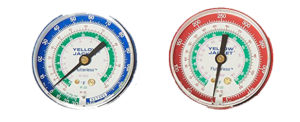
What is an HVAC Technician?
An HVAC Technician (Heating, Ventilating, and Air-Conditioning) is a person that installs, maintains, and troubleshoots building climate-control appliances, refrigeration equipment, and industrial processes requiring temperature control in manufacturing.
Competent HVAC Techs have knowledge of the chemical properties of refrigerants and their changing states and characteristics under the various equipment and environmental operating conditions encountered during the course of daily installation, service, and repair of such equipment.
They are also required to have a good rounded knowledge of other fluid and mechanical systems including natural gas, LP gas, water, and of course air flow. (Yes air is considered a fluid system).
And of course a good tech has an understanding of electricity and magnetism as this knowledge has to be applied on their jobs on a daily basis for troubleshooting problems with refrigeration and air-conditioning motors, contactors, and other equipment. Many HVAC/R trouble calls are electrical in nature so an understanding of electrical properties is absolutely essential to resolving calls in a timely manner.
Handling Refrigerants Requires EPA Certification
HVAC or HVAC/R techs in the USA are required to be certified by the Environmental Protection Agency for handling refrigerants. There are several types of certifications depending on the appliances a technician will be servicing and installing. More information on the EPA 608 certifications here:
ATTENTION! New 2019 EPA 608 leak-rate mandates!
As of January 1 2019, new 608 regulations became effective regarding the leak-rates on comfort cooling and industrial process refrigeration.
New Refrigerant Leak-Rate Thresholds Effective January 1 2019
- 30% for Industrial Process Refrigeration
- 20% for Commercial Refrigeration
- 10% for Comfort Cooling
Previous Refrigerant Leak-Rate Thresholds:
- 35% for Industrial Process Refrigeration
- 35% for Commercial Refrigeration
- 15% for Comfort Cooling
In addition, leak inspections are a mandatory requirement if you exceed the leak rates as outlined above. Effective January 1 2019, if your customers appliance exceeds those threshold leak-rates, you will have to perform inspections as follows:
- Commercial Refrigeration and IPR Systems with 500 lbs plus: For equipment with a full 500 lb charge or more, leak inspections must be conducted once every three months until such time that your leak-rate calculations show that you have not exceeded the threshold limit for four quarters of consecutive reporting.
- Commericial Refrigeration and IPR Systems with 50 lbs to less than 500 lbs: For equipment with a full charge of more than 50 but less than 500 pounds of refrigerant, leak inspections must be conducted once per calendar year until such time your leak-rate calculations show that you have not exceeded the threshold limit for one year.
- Comfort Cooling systems of 50 lbs or more: For comfort cooling appliances with 50 lbs or more , leak inspections must be conducted once per calendar year until such time your leak-rate calculations show that you have not exceeded the threshold limit of 10% for one year.
In addition to this, after leak repairs on any of these appliance types you will need to conduct an initial test for verification as well as a follow-up.
Bottom line: Your customers or your facility has to be more vigilant with their maintenance program if they are currently struggling with getting a handle on refrigerant leak issues or it will be more costly for them.
HVAC Tech Navigation
| EPA 608 Cert | Refrigerants |
| HVAC Fail |
Building Trades Navigation
| Electricians | HVAC Techs |
| Plumbers | Resources |
